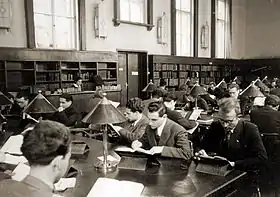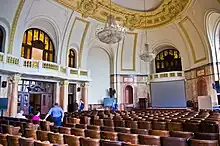Софийски университет | |
| Latin: Universitas Serdicensis | |
Former name | Higher Pedagogical Course |
|---|---|
| Motto | Ipsa scientia potestas est |
Motto in English | Knowledge itself is power |
| Type | Public |
| Established | 1 October 1888 |
| Affiliation | EUA |
| Endowment | $125 million |
| Rector | Georgi Valchev |
Academic staff | 1,700 |
| Students | 18,911 (2019) |
| Address | , , 42°41′37″N 23°20′6″E / 42.69361°N 23.33500°E |
| Campus | Urban |
| Language | Bulgarian |
| Colors | Purple |
| Website | uni-sofia |
| University rankings | |
|---|---|
| Global – Overall | |
| THE World[1] | > 800 (2020) |
| Regional – Overall | |
| QS Emerging Europe and Central Asia[2] | 44 (2022) |
Sofia University "St. Kliment Ohridski" (Bulgarian: Софийски университет „Св. Климент Охридски“) is a public research university in Sofia, Bulgaria. It is the oldest institution of higher education in Bulgaria.
Founded on 1 October 1888, the edifice of the university was constructed between 1924 and 1934 with the financial support of the brothers Evlogi Georgiev and Hristo Georgiev (whose sculptures are now featured on its façade) and has an area of 18,624 m2 and a total of 324 premises. The university has 16 faculties and three departments, where over 21,000 students receive their education. The current rector is Georgi Valchev.
It has been consistently ranked as the top university in Bulgaria according to national and international rankings, being constantly among the best four percent of world universities according to QS World University Rankings.
History

The university was founded on 1 October 1888—ten years after the liberation of Bulgaria—to serve as Bulgaria's primary institution of higher education. Initially, it had four regular and three additional lecturers and 49 students. It was founded as a higher pedagogical course, it became a higher school after a few months and a university in 1904.[3][4] The first rector was Bulgarian linguist Aleksandar Teodorov-Balan.
During Sofia University's first years, it had three faculties, namely a Faculty of History and Philology (since 1888), a Faculty of Mathematics and Physics (since 1889) and a Faculty of Law (since 1892). History, geography, Slavic philology, philosophy and pedagogics, mathematics and physics, chemistry, natural sciences and law were also taught.[3] The first women (16 in number) were welcomed to the university in 1901 and 25 November (8 December N.S.), the day of St. Kliment of Ohrid, became the university's official holiday the following year.
As Prince Ferdinand opened the National Theatre in 1907, he was booed by Sofia University students, for which the university was closed for six months and all lecturers were fired. Not until a new government with Aleksandar Malinov at the head came into power in January 1908 was the crisis resolved.
At the beginning of the Balkan Wars, 1,379 students (725 men and 654 women) were recorded to attend the university. A fourth faculty was established in 1917, the Faculty of Medicine, the fifth, the Faculty of Agronomy following in 1921, the Faculty of Veterinary Medicine and the Faculty of Theology being founded in 1923. In 1922–1923, Sofia University had 111 chairs, 205 lecturers and assistants and 2,388 students, of which 1,702 men and 686 women.
The foundation stone of Sofia University's new edifice was laid on 30 June 1924. Funds were secured by the brothers Evlogi Georgiev and Hristo Georgiev. The rectorate was built according to the initial plans of the French architect Henri Bréançon, who had won a competition for the purpose in 1907. The plans were developed by Nikola Lazarov and revised by Yordan Milanov, who also directed the construction, but died before the official opening on 16 December 1934.
On 27 October 1929, the first doctoral thesis in natural science of the university was defended by geologist Vassil Tzankov. The second one in chemistry followed on 1 July 1930 and the title doctor was granted to Aleksandar Spasov. In 1930–1931, the university had four more doctors.
After the political changes of 9 September 1944 and the emergence of the People's Republic of Bulgaria, radical alterations were made in the university system of the country. At that time in 1944–1945, 13,627 students attended the university, taught by 182 professors and readers and 286 assistants. Communist professors were introduced to the higher ranks of university authority, with others that did not share these views being removed. Specific party-related chairs were established and the university was restricted after the Soviet model. Three new faculties were founded in 1947, one of forestry, one of zootechnics and one of economics and major changes occurred, with many departments seceding in later years to form separate institutions.
In 2001, the Sofia University was the first Bulgarian Athenaeum to open a Theological Faculty ruled by the national Orthodox Church after the fall of communism.[5]
Sofia University Mountains on Alexander Island, Antarctica were named for the university in commemoration of its centennial celebrated in 1988 and in appreciation of the university's contribution to the Antarctic exploration.
Faculties and departments
Faculties




Sofia University offers a wide range of degrees in 16 faculties:
- Faculty of Biology
- Faculty of Chemistry and Pharmacy
- Faculty of Classical and Modern Philology
- Faculty of Economics and Business Administration
- Faculty of Education
- Faculty of Geology and Geography
- Faculty of History
- Faculty of Journalism and Mass Communication
- Faculty of Law
- Faculty of Mathematics and Informatics
- Faculty of Philosophy
- Faculty of Physics https://www.phys.uni-sofia.bg
- Faculty of Pre-school and Primary School Education
- Faculty of Slavic Studies
- Faculty of Theology
- Faculty of Medicine
Departments
- Department of Language Learning
- Department for Information and In-service Training of Teachers
- Sports Department
Affiliated bodies
Notable alumni
 Elisaveta Bagryana, poet
Elisaveta Bagryana, poet Anthony Bailey, businessman
Anthony Bailey, businessman Pepka Boyadjieva, sociologist
Pepka Boyadjieva, sociologist Kiril Bratanov, scientist
Kiril Bratanov, scientist Iván Cepeda, politician and senator of Colombia
Iván Cepeda, politician and senator of Colombia Ljubomir Chakaloff, mathematician
Ljubomir Chakaloff, mathematician /
/ Boris Christoff, opera singer
Boris Christoff, opera singer.svg.png.webp) Raymond Detrez, historian
Raymond Detrez, historian Philip Dimitrov, politician and lawyer, former Prime Minister of Bulgaria and member of the Constitutional Court of Bulgaria
Philip Dimitrov, politician and lawyer, former Prime Minister of Bulgaria and member of the Constitutional Court of Bulgaria Todor Georgiev, scientist and inventor
Todor Georgiev, scientist and inventor Khristo Ivanov, scientist
Khristo Ivanov, scientist Rostislaw Kaischew, scientist
Rostislaw Kaischew, scientist Ivan Kostov, politician and economist, former Prime Minister of Bulgaria
Ivan Kostov, politician and economist, former Prime Minister of Bulgaria /
/ Julia Kristeva, philosopher and writer
Julia Kristeva, philosopher and writer Maxim, cleric and head of the Bulgarian Orthodox Church
Maxim, cleric and head of the Bulgarian Orthodox Church Georgi Nadjakov, physicist
Georgi Nadjakov, physicist Ivan Kostov Nikolov, geologist and mineralogist
Ivan Kostov Nikolov, geologist and mineralogist Ya'akov Nitzani, politician, Knesset member
Ya'akov Nitzani, politician, Knesset member Georgi Parvanov, former President of Bulgaria
Georgi Parvanov, former President of Bulgaria /
/ Ivan Georgiev Petrov, physicist
Ivan Georgiev Petrov, physicist Assen Razcvetnikov, poet, writer and translator
Assen Razcvetnikov, poet, writer and translator Dimitar Sasselov, astronomer
Dimitar Sasselov, astronomer Lachezara Stoeva, diplomat
Lachezara Stoeva, diplomat Petar Stoyanov, former president of Bulgaria
Petar Stoyanov, former president of Bulgaria /
/ Ivan Stranski, physical chemist
Ivan Stranski, physical chemist /
/ Tzvetan Todorov, philosopher
Tzvetan Todorov, philosopher Orlin D. Velev, professor and scientist
Orlin D. Velev, professor and scientist Mikhail Wehbe, diplomat
Mikhail Wehbe, diplomat Zhelyu Zhelev, former President of Bulgaria
Zhelyu Zhelev, former President of Bulgaria Maria Zheleva, filmmaker and former First Lady of Bulgaria
Maria Zheleva, filmmaker and former First Lady of Bulgaria Lyudmila Zhivkova, politician
Lyudmila Zhivkova, politician
Faculty
- Snejina Gogova, sinologist, sociolinguist and psycholinguist, Professor of Chinese linguistics
Partner Universities
Europe
Humboldt-Universität Berlin, Technische Universität Dresden, Université de Genéve, Université libre de Bruxelles and others.
See also
Notes and references
- ↑ "World University Rankings 2020". THE Education Ltd. Retrieved September 14, 2019.
- ↑ "QS World University Rankings-Emerging Europe & Central Asia". Retrieved 15 January 2023.
- 1 2 Bourchier, James David (1911). . In Chisholm, Hugh (ed.). Encyclopædia Britannica (11th ed.). Cambridge University Press. p. 779: Education....
- ↑ Pundeff, Marin (September 1968). "The University of Sofia at Eighty". Slavic Review. 27 (3): 438–446. doi:10.2307/2493343. JSTOR 2493343. S2CID 164056461.
- ↑ Merdjanova, Ina (December 1, 2006). "Uneasy Tolerance: Interreligious Relations in Bulgaria after the Fall of Communism". Occasional Papers on Religion in Eastern Europe: 3. ISSN 1069-4781. OCLC 8090922257. Archived from the original on September 22, 2017.
External links
- Sofia University website (in Bulgarian and English)
- "Sofia University "St. Kliment Ohridski"" (in Bulgarian). Sofia municipality website. Archived from the original on 17 March 2003. Retrieved 4 April 2006.
- Efficiency and public funding for higher education in Bulgaria
